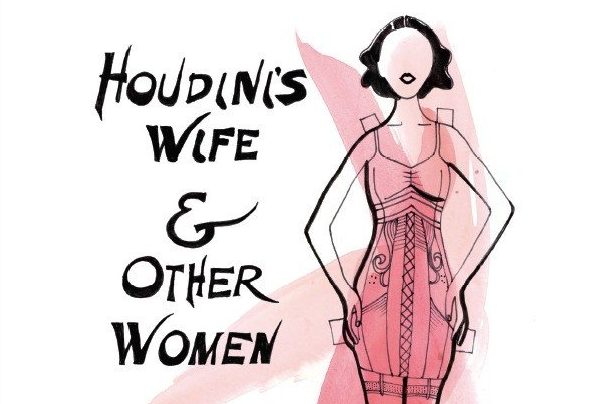Houdini’s Wife and Other Women by Amy Schreibman Walter
– Reviewed by John Mee –
Houdini’s Wife and Other Women, published by Chicago-based dancing girl press, is Amy Schreibman Walter’s second pamphlet. According to the blurb, the poems in the pamphlet are about a variety of “American women, wives and lovers span[ning] the decades of the 20th century” who “though wildly different, share one trait – loving the men in their lives deeply, often problematically”. A number of the poems feature identifiable historical figures such as Zelda Fitzgerald, Bess Houdini and Dorothy Young, who began her career as one of Harry Houdini’s stage assistants. The majority of the poems, though, are written from the viewpoint of an unnamed (and presumably 21st century) female narrator.
The voice in the personal poems is likeable and self-deprecating, as in “After”:
I was always running into open cabinet doors
knocking over whole bags of flour
in my little kitchen (built, surely, for a small woman)
There is a dreamy quality to the voice at times, as in “Coliseum”, where the narrator meets a blind man at the Coliseum who asks her “‘Is it beautiful? Tell me, what do you see?’” She tells him “about you; how I wander round ruins, / writing to you in my head.”
Not all the poems have this wistful tone. The opening poem, “Date Night”, begins in a nautically-themed bar and escalates fairly rapidly:
… And later, your sweat,
rolling down your neck, down your back,
falling into the crevices between my fingers,
into my palms, my hands flat on your back,
collecting your sweat.
There is a similarly muscular feel to “You Took Me to the Frick”. In Manhattan’s Frick Collection, the protagonists stand in front of a Goya painting of “stout Spanish men, axes // in their rough hands, bashing metal, making/ something, or destroying”. The painting contrasts with the others in the gallery:
… so many doe eyed, elegant women –
so many women in the Frick. Against
the roughness of men, in sweat –parched by sun
This poem also ends in intimacy:
Your tongue found mine while
men on the wall were hammering,
hunched over an amorphous metal,
delivering strong, steady blows.
An earlier poem, “TV-Land”, invokes the sixties sitcom I Dream of Jeannie. The narrator “could be a blonde with bangs … / … my mini-dress the colour of ripe pineapples”. Then:
Breakable vases would fall to the floor every time
we kissed, up against cheap plywood bookshelves,
cueing canned laughter.
This poem has charm (even if, arguably, the adjectives “breakable” and “cheap” are redundant in the lines quoted above). This time, the poem’s sexual conclusion is imagined by the narrator: “I see us, but younger – limbs / entwined on a stripy sixties sofa, our very own 25 minute episode.” The lovers in “Stella by Starlight”, named for a jazz standard, also come together by the end: “the first time I ever put my hands in your front pockets, fingers / feeling through fabric, to your thighs”. This prose poem has its merits, though I wondered if, by ending with a description of the morning sunrise after a party as “almost an elegy”, the poet was naming the mood rather than creating it for the reader.
The poems with a historical slant covered an interesting range of subjects, and the understated approach worked well in some of these poems, notably in “Houdini’s Wife” and “Dorothy Young, 1925”. I was less persuaded by “Mamah Borthwick Cheney, 1909”, a poem about the woman whose relationship with architect, Frank Lloyd Wright, scandalised public opinion at the time. In this instance, the backstory – the two left their respective spouses and children to live together – seemed more intriguing than the poem.
I was also unconvinced by another of the longer poems in the pamphlet, “Six Before Breakfast”. The Mad Hatter’s proclamation that “I believe in impossible things – six alone, just before breakfast” provides the title for the poem; this line also appears in the poem’s epigraph and, with minor modification, twice more in the poem. This repetition did not seem to be earned. More generally, it felt like I had already been taken down this particular “rabbit hole” in other writers’ poems.
As an Irish reviewer of an American writer based in England, there is inevitably a danger that I am missing important cultural references. Furthermore, I bring a male perspective to a book which foregrounds the experience of women. Acknowledging these points, my subjective opinion was that, although there was a lot to like, the pamphlet was not entirely satisfying. For the most part, the writing is low-key, with comparatively little in the way of verbal playfulness or striking imagery.
Poems such as “Walking the Frick” (a second Frick poem) and “Coliseum” felt slight and a number of other poems, although having attractive features, seemed to need further depth – whether in verbal, formal or emotional terms. This writer is clearly able to experiment successfully, as is illustrated by her “Online Dating Inbox” (not in the pamphlet under discussion). The risks taken at times in the pamphlet, e.g. in “Date Night” and “You Took Me to the Frick”, may be an indication of the way forward for her work.





